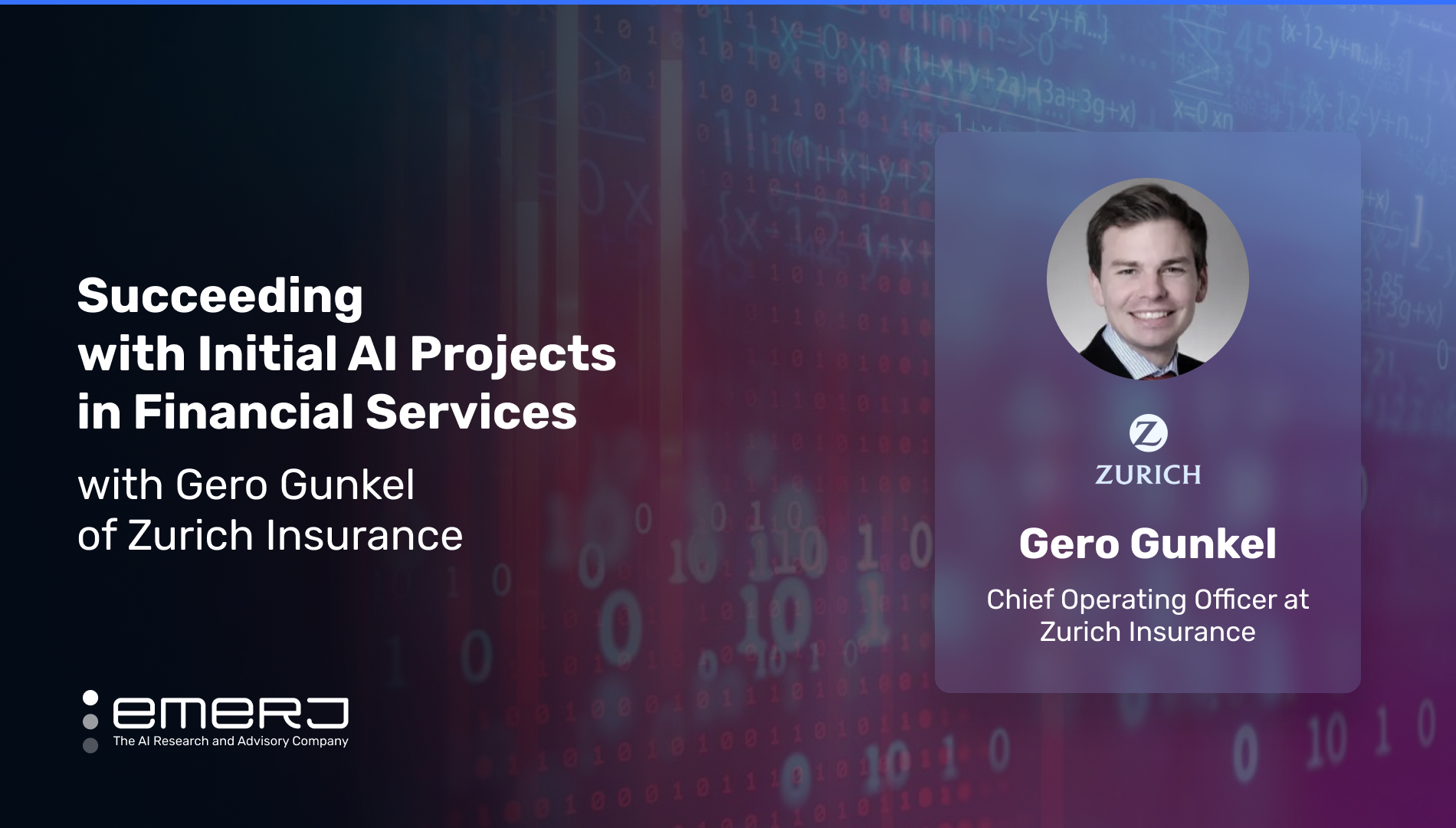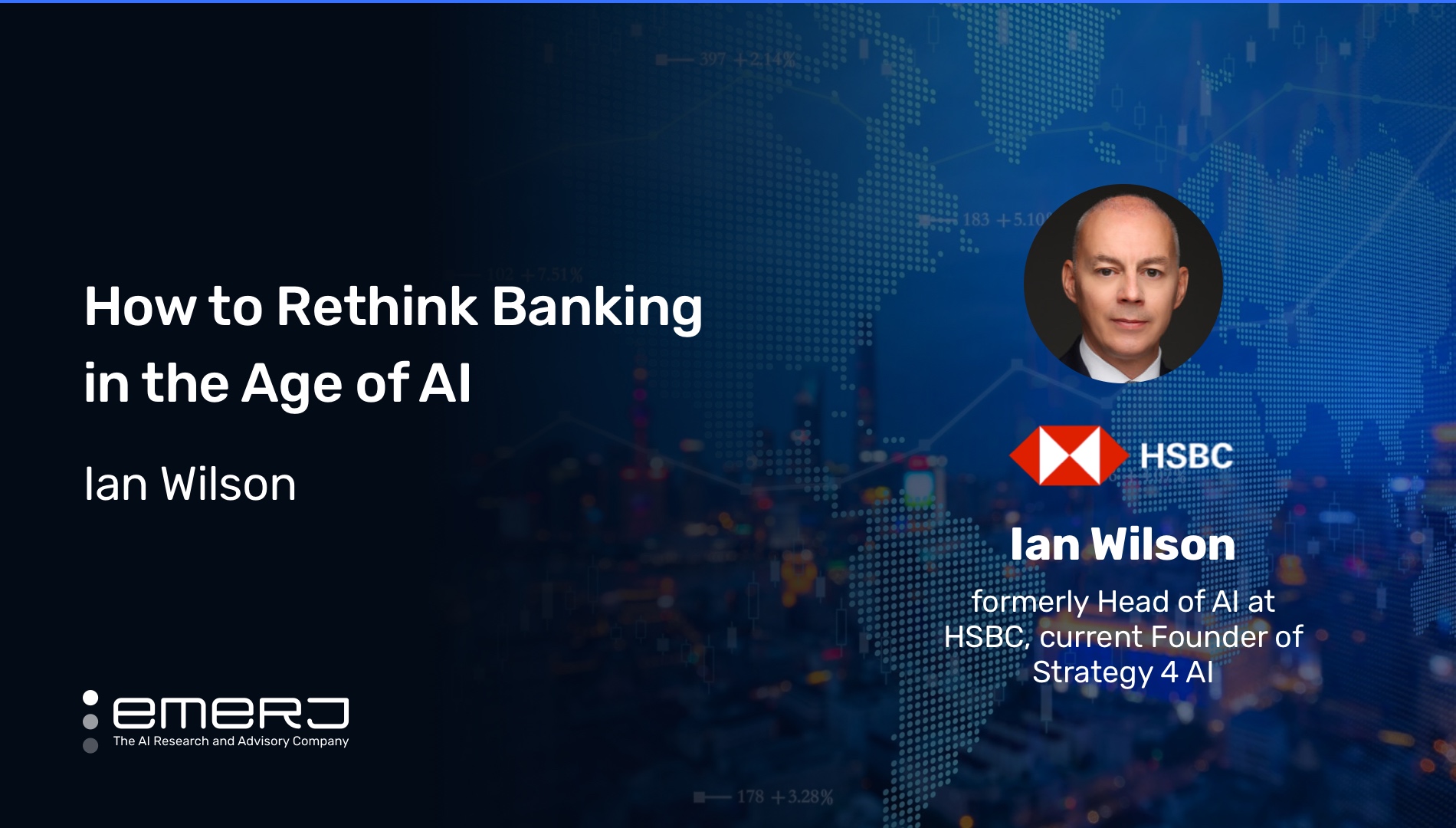Succeeding with Initial AI Projects in Financial Services – with Gero Gunkel of Zurich Insurance
Starting an early AI project is challenging for large and small enterprises. Perhaps no industry is more aware of these challenges than the highly regulated and especially tradition-oriented financial services sector.
Yet despite these challenges, prolific AI adoption in financial services continues. According to an International Data Corporation (IDC) report, the banking sector will be the second-highest spending industry on AI technologies from 2021 through 2025. Together with retail, banking will account for 28 percent of a $120 billion total.
Such rapid investment is due to how much AI has to offer FS firms. The list of potentially ROI-adding AI use cases includes fraud prevention, risk management and process automation, to name a few. The money follows where rewards are to be had. In a McKinsey report [pdf] analyzing 25 AI use cases across financial services, the authors conclude that AI can add up to $1 trillion in additional value.
However, that first step in the thousand-mile journey of AI adoption for financial leaders should be carefully considered and planned if one desires to reap any rewards. Once you have that initial success, you can more seamlessly — and confidently — focus on more complex projects with perhaps even greater ROI.
So, what do the first steps of an initial AI project look like? What are the steps involved to get there? How do business leaders scale these AI capabilities?
Gero Gunkel is the Chief Operating Officer at Zurich Insurance’s Customer Active Management or ZCAM. Before becoming COO, Gero was the Global Head of AI at Zurich Insurance, a position he held for nearly five years. As the head of a large global multinational enterprise dealing specifically with leveling up AI, Gero has some valuable advice for leaders in overcoming challenges from the initial stages of deploying AI projects.
In a value-adding conversation with Emerj CEO Daniel Faggella on the AI in Business podcast, Gero elaborates on two distinct topics:
- Start where the data is: It’s easier to scale and gain buy-in from stakeholders for early AI initiatives through effective process discovery and prioritizing data-rich, easy-to-automate projects.
- Having a mindset of “Think big, start small”: Choose an initial AI project that delivers practical, short-term value to stakeholders while serving essential business functions that stand to transform an organization if built at scale.
Listen to the full episode below:
Guest: Gero Gunkel, COO of ZCAM and former Global Head of AI, Zurich Insurance
Expertise: Data science, Automation, AI/ML Product development, AI/ML Project management
Brief Recognition: Prior to his promotion to COO at Zurich’s data insights start-up, Zurich served as the Global Head of AI at the company. In 2017, Gero won Gartner’s prestigious Eye on Innovation award for financial services.
Start Where the Data Is
Gero advises business leaders that effective process discovery in early AI initiatives depends on “process stability,” says Gero. In other words, they need processes that retain the same functions in the first 1-2 years of operation.
He continues, “because if you start to apply AI to a process, and you train on historical data, it is very important that this historical data and future data are very similar.”
For Gero and his team at Zurich Insurance, email communications, in particular, seemed to fit the criteria:
- Their compliance teams and other silos were having tremendous difficulty tracking emails.
- All indications showed email processes would remain the same over the next 48 months.
- Email communications data tends to be more uniform than most historical data.
Once you have your processes and reasonably transferable data between them, Gero lays out a two-step framework that enterprise leaders can implement to help their organizations find promising “low-hanging fruit” applications.
First – in looking at data across operations – engage stakeholders and team members by asking essential questions: “Where do we see similar problems? Where do we see similar processes in the first tab, really filter down which areas that, if we’re successful, can actually move the needle? Because I think that’s kind of important to say, ‘What’s our total addressable opportunity with AI?'” says Gero.
Getting business users and business stakeholders involved from day one is a top priority, says Gero – and asking where they see common patterns in different business operations is an excellent way for siloed teams to start sharing the same language. Relatedly, avoid letting teams work on projects with varying levels of focus because they’re in isolation – or, as Gero puts it, only engaging in projects “just for the techies.”
Gero also recommends that financial services leaders distinguish between those high-frequency, high-volume and low-frequency cases, bearing in mind that it is generally easier to train an algorithm on the former.
Next, filter down the processes to one or more that can move the needle in the right direction if the AI is successful. Gero advises grabbing a handful of project proposals and then determine with the users and stakeholders where enough process stability and data exist to ensure the project’s increased likelihood of success.
In this way, you are creating a joint proposal and, as a result, have a much higher chance of gaining the support of the business users and stakeholders.
Thinking Big, Starting Small
Gero shares his perspective on gaining stakeholder support by first “starting small” in choosing viable, stable, and scalable AI projects. Suppose these AI projects are to retain long-term viability. In that case, leaders must simultaneously “think big” in the process discovery phase by focusing early AI initiatives on business functions directly tied to the organization’s mission and bottom line.
That said, “thinking big” may not be the best way to lead with stakeholders at first, as not to overwhelm their natural skepticism for significant – and seemingly unnecessary – change.
Gero gives the example of a specific use case at Zurich, where the volume of incoming customer and partner emails increased exponentially due to seasonality. This problem resulted in delayed response times and a less-than-desirable customer experience.
Given the size of Zurich Insurance, the team would eventually deploy a more extensive and comprehensive solution. However, the company wanted to realize some early wins. The team found a painless, simple way to embed AI into the email automation solution.
Gero describes the workflow that developed from Zurich Insurance’s initial AI project as follows:
- Users entered email communications data from the CRM into an early AI risk model
- The AI model made suggestions for risk classifications of each communication that users could accept or reject
- Users sent rejections back into the model for retraining
Because Gero’s team plugged in the right AI by employing a phasic strategy at the beginning of the process, it realized some early gains and gained momentum. The company had a valuable initial solution to allocate emails and tasks to the right team.
When it was time for Zurich to scale its AI, the company integrated a simple user feedback method to reduce task ambiguity and improve its current working model.
Gero tells Emerj there were cases in which he was “very certain” about what needed to be done and required no further feedback. “But there were other cases where I was not certain enough of what to do,” and through a thorough examination, feedback proved immensely valuable in these areas. The feedback loop, in particular, became “so intuitive and easy” for users that it became the primary driver of accurate outcomes for the entire project.
Initial success may lead to a natural evolution of a more complex and comprehensive final product. Again Gero uses the example of his team’s email automation solution:
“Ultimately, it’s really important to show initial benefit and initial value to your stakeholders and also to your users. So they’re willing to continue to give feedback, and they’re willing to go with you on this change journey. That’s why we really started small, with a few image categories, focusing on the high-frequency case while low-frequency cases were brought to a different channel. And once we got some initial success, we started to include more different categories. And we started to build on it with new use cases, like information extraction. But I think the one key lesson for us was really dream big, but start small, because it is easy success to keep running.”
– COO of ZCAM and former Global Head of AI at Zurich Insurance, Gero Gunkel







